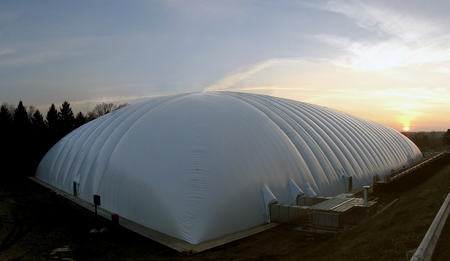
We collect basic website visitor information on this website and store it in cookies. We also utilize Google Analytics to track page view information to assist us in improving our website.
This seems like an odd question, doesn’t it? I mean, of course they’re round, that’s why we call them bubbles! But why aren’t they square like every other building? Could we make a square air structure if we wanted to?
While the answers might seem obvious to some, there’s actually a perfectly reasonable—and intuitive—answer to “Why are inflatable structures round?” Air structures are round because of physics, cost, and simplicity.
 |
Physics of Bubbles
Imagine something being inflated. In your mind’s eye, you are likely seeing something like a balloon or a bubble. This is the shape you expect it to be because of physics and entropy. The second law of thermodynamics concludes that energy within a system will equilibrate within that system. When inflating an object, this means that the added energy (inflating the object) will spread out equally in all directions. If something is pushing in all directions equally, what shape do you get? A sphere.
A sphere is the most efficient shape at holding something (such as air) with the least amount of energy lost. If one side of the inflated object were expanding more than the other, more energy would be exerted unevenly on that one side.
A sphere provides the maximum amount of internal space, with the least amount of surface area. For domes, this means we can create more space, using fewer materials. A square air structure would need more fabric to fit the same volume.
The Strength of the Dome Shape
The same physics that creates a bubble shape when something is inflated, also means that the shape that is produced is as strong as it could possibly be. Rounded shapes occur in nature all of the time because the dome shape provides strength.
For example, think about an egg. While eggshell is a fragile material, the egg itself is incredibly strong. You may remember the grade school experiment of balancing books on top of eggs. Of course, we don’t pile anything heavy on top of an air dome, but the shape itself provides more strength than any other to oppose the forces (mostly the internal pressure) acting on the bubble.
Simple Domes are Best
Finally, like most designs, simple is always better. As any engineer knows, when you introduce more complexity to a design, you also bring more variables and potential sources of failure. Besides the fact that a dome shape is the strongest, the more material that is added to create a shape that isn’t a dome creates more seams and failure points that need to be strengthened.
Tried and tested, the dome shape of air structures are here to stay. The shape of a bubble is the simplest, strongest, and most cost effective shape for any air structure. Thinking about this, the solution to “Why are air structures round?” is obvious, and intuitive. Nature created and uses the shape all the time and air domes simply take advantage of this!
